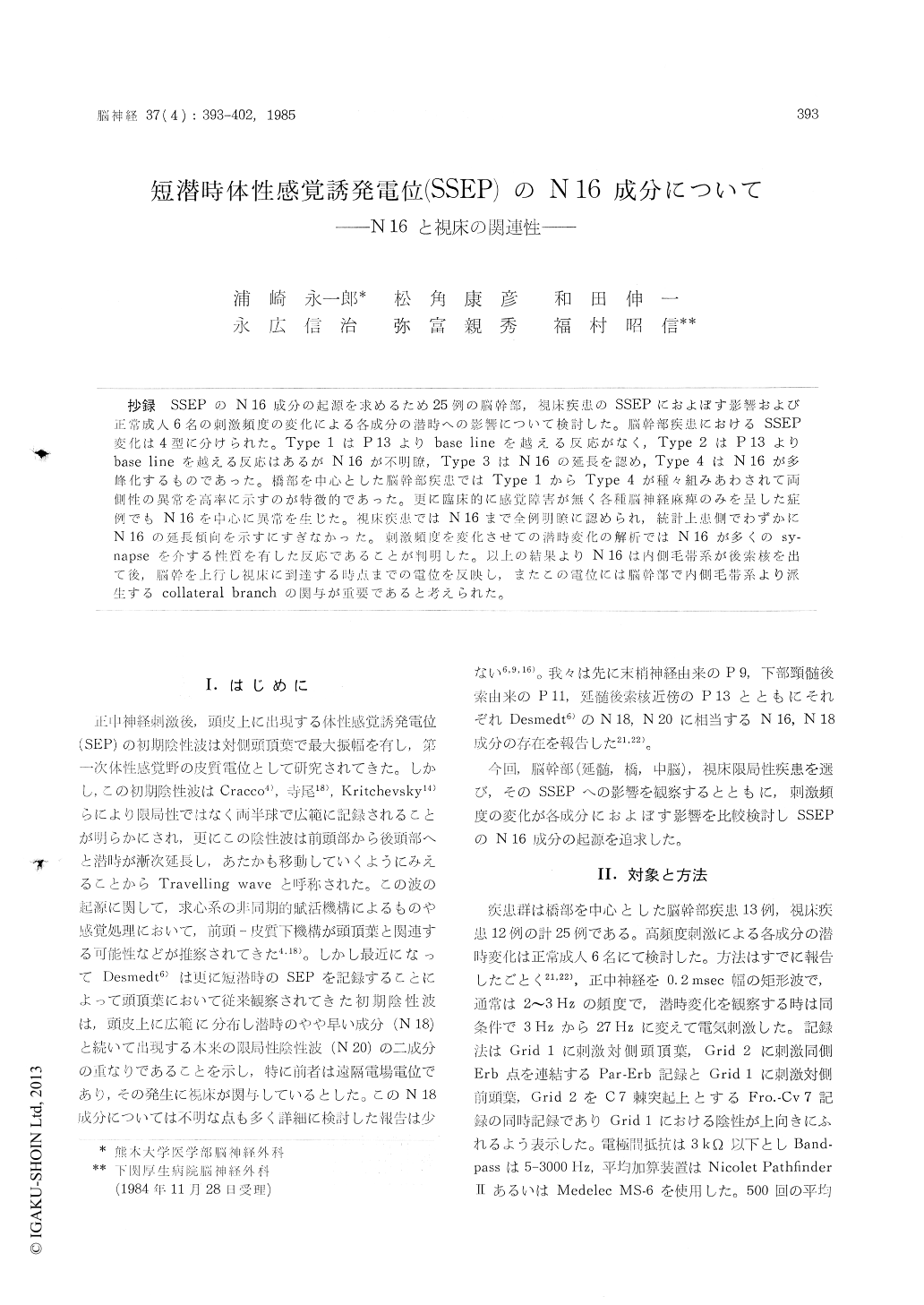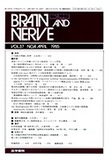Japanese
English
- 有料閲覧
- Abstract 文献概要
- 1ページ目 Look Inside
抄録 SSEPのN16成分の起源を求めるため25例の脳幹部,視床疾患のSSEPにおよぼす影響および正常成人6名の刺激頻度の変化による各成分の潜時への影響について検討した。脳幹部疾患におけるSSEP変化は4型に分けられた。Type1はP13よりbase lineを越える反応がなく,Type2はP13よりbase lineを越える反応はあるがN16が不明瞭,Type 3はN16の延長を認め,Type4はN16が多峰化するものであった。橋部を中心とした脳幹部疾患ではType1からType4が種々組みあわされて両側性の異常を高率に示すのが特徴的であった。更に臨床的に感覚障害が無く各種脳神経麻痺のみを呈した症例でもN16を中心に異常を生じた。視床疾患ではN16まで全例明瞭に認められ,統計上患側でわずかにN16の延長傾向を示すにすぎなかった。刺激頻度を変化させての潜時変化の解折ではN16が多くのsy—napseを介する牲質を有した反応であることが判明した。以上の結果よりN16は内側毛帯系が後索核を出て後,脳幹を上行し視床に到達する時点までの電位を反映し,またこの電位には脳幹部で内側毛帯系より派生するcollateral branchの関与が重要であると考えられた。
Short latency somatosensory evoked potentials (SSEP) to median nerve stimulation consists of four main subcortical components, namely P 9, P 11, P 13 and N 16 which appears before cortial N 18. However, the origin of component N 16 is a subject of controversy.
In an attempt to learn about the generator source (s) of component N 16, SSEP was recorded from 25 patients with various focal lesions of the brain stem and/or thalamus, and abnormalities of the each potential was correlated to the clinically and radiologically defined site of the lesions. Furthermore, the effects of the different frequency in stimulation were also investigated in 6 normal subjects, because latency changes of each compo-nent might contribute to the understanding of the generation.
Recordings were obtained from 13 patients with brain stem lesion which included 3 cases with pontine hemorrhage, 3 cases with pontine tumor, 3 cases with cerebello-pontine angle tumor, one case of pontine angioma, one case of chordoma, one case of tentorial tumor and one case of MLFsyndrome. SSEP changes in these cases were clas-sified into four types as follows : type 1 ; no re-sponse over the base line was recorded, type 2 ; some responses over the base line were recorded but N 16 was uncertain, type 3 ; component N 16 was cleary identified but its latency was signifi-cantly prolonged, type 4 ; component N 16 was divided into two peaks. Bilateral abnormality on SSEP with splitted combination of these four types in various degree was obseved. Furthermore, these SSEP abnormalities were seen even in the some cases without sensory disturbance.
On the other hand, component N 16 was clearly identified in all 12 patients with thalamic lesion which included 11 cases with thalamic hemorrhage and one case with thalamic tumor on the effected side. Comparison of latency and amplitude bet-ween normal side and affected side statistically showed no laterality of components P 9, P 11 and P 13, but a tendency of delay in latency of com-ponent N 16 on the affected side.
Different stimulus repetition rate revealed some other characteristics of each component. Electrical stimuli to median nerve at the wrist were deli-vered at rates of 3, 6, 9, 12, 15, 18, 21, 24 and 27 Hz. Latencies of components P 9, P 11, P 13, N 16 in Fro.-Cv 7 lead and component N 18 in Par.-Erb lead were measured and all latency changes werecaluculated relative to the 3 Hz stimulation. P 9 and P 11 showed continually stable in latency through 3 to 27 Hz, while P 13, N 16 and N 18 were prolonged in latency with increasing rate. Especially, N 18 could not be obtained in 2 sub-jects when the rate of stimulation was up to 9 or 12 Hz. Comparison between the latency changes of P 9 and those of following components under the same stimulus rate was carried out statistically. The test showed no significant difference at all stimulus rates between P 9 and P 11, however, P 13 was significantly prolonged than P 9 at 24 Hz stimulation and N 16 and N 18 were also signifi-cantly prolonged than P 9 when the stimulation was up to 12 Hz.
The suggestion was made that P 9 and P 11 were generated by the first order neurons and P 13 was a potential interposed by the synaptic event, while N 16 and N 18 were potentials inter-posed by two or more synaptic events.
In conclusion, the result of this study indicated that component N 16 mainly reflected the activi-ties of the subthalamic source (s), especially, it was strongly suggested collateral branch from the me-dial lemniscal pathway in the brain stem region was important for the generation of component N 16.

Copyright © 1985, Igaku-Shoin Ltd. All rights reserved.


